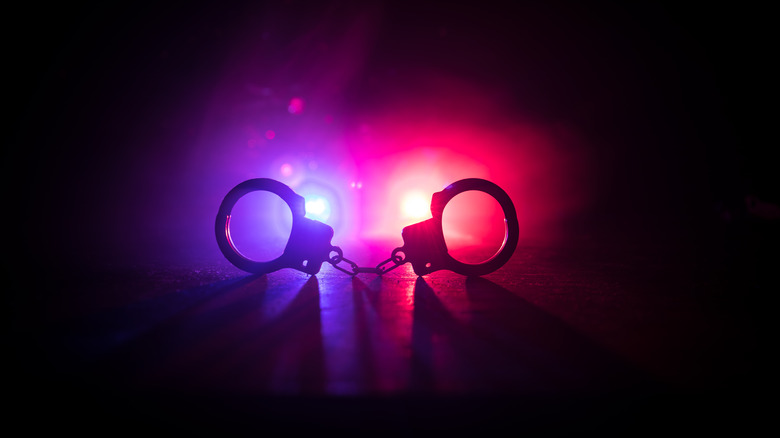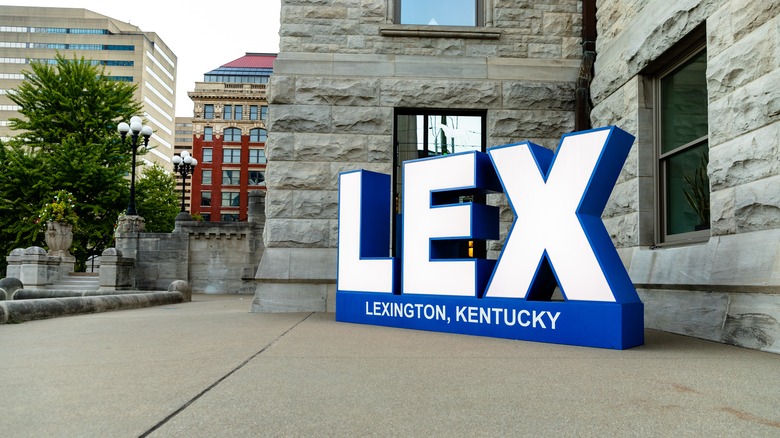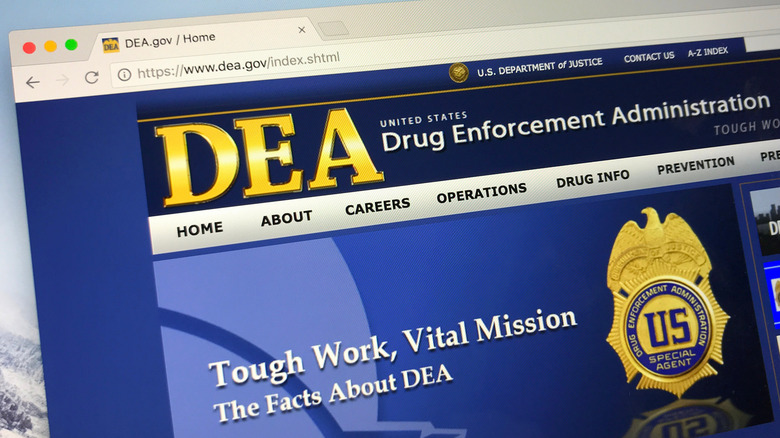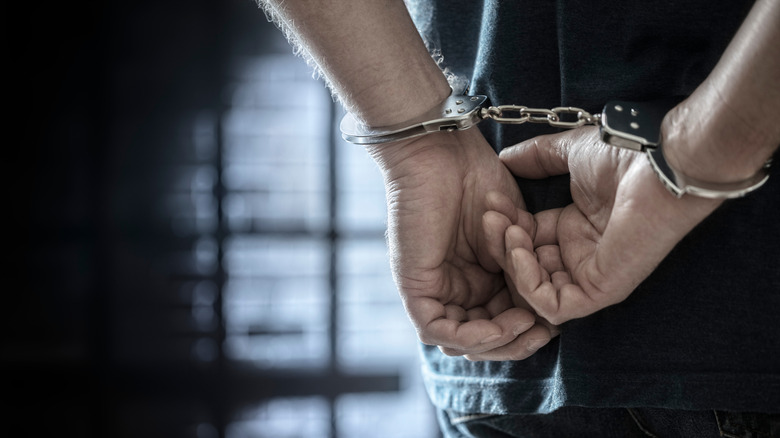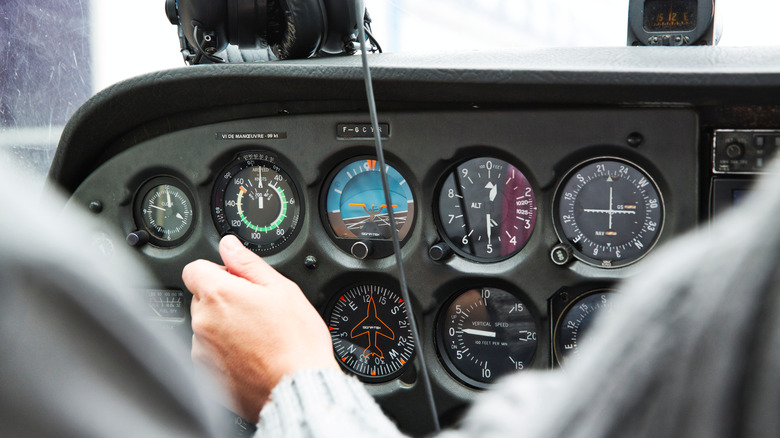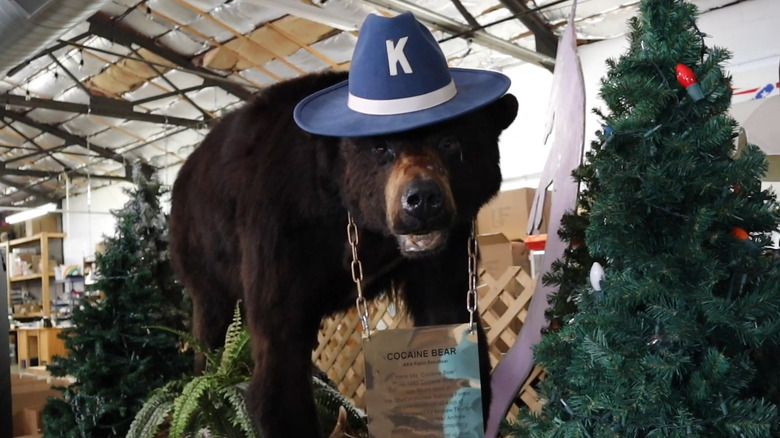The Wild Life Of Cop-Turned-Criminal Andrew Thornton, The Man Behind Kentucky's Cocaine Bear
On September 11, 1985, a man named Fred Myers saw a man in his backyard in his Knoxville, Tennessee, residence. Upon closer inspection, Myers discovered that the man appeared to be dead, and he alerted the authorities at about 8:30 a.m. "I just didn't want to touch him or disturb him. I let the law do it. I just left him laying there," he told UPI. Authorities arrived at the scene and found that the deceased individual had several items with him. He was wearing night vision goggles and a bulletproof vest, and he carried two pistols and additional ammunition.
As reported by the Washington Post, other items found at the scene were food rations, vitamins, a compass, six gold Krugerrands, $4,500 in cash, and other survival gear. An Army duffel bag was also found and inside were several bundles of cocaine that weighed 77 pounds and were worth $13 million. It was determined that he plunged to his death between midnight and 3 a.m. on the morning he was found when his parachute failed to open. The Federal Aviation Administration reported that all flights for the previous night were accounted for, and if the deceased man was smuggling drugs, his flight plan wouldn't have been filed anyway. The man was later identified as 40-year-old Andrew Carter Thornton II.
Andrew Thornton II's background
Andrew Thornton II was born in 1945 in Lexington, Kentucky, to horse breeders Carter and Peggy. Thornton was an obedient child who didn't get into trouble, and he had a privileged upbringing. He attended a prestigious private school in his youth and joined a military academy to become a paratrooper, as reported by The Liberator. In the 1960s, he was sent to the Dominican Republic after a revolution where he was wounded, and he received a Purple Heart. One of his friends told the Los Angeles Times, "He was an expert skydiver and the type of guy who wouldn't even let anyone touch his pack. He was a fanatic."
In 1968, Thornton joined the Lexington police force while simultaneously earning his law degree at the University of Lexington. During his time with the police department, he worked for three years as part of the narcotics squad. It was during that time that he turned his back on the law and stole drugs seized as evidence and sold them. According to The Washington Post, Thornton worked closely with the DEA and was described as "an adventurer driven by adrenaline rushes," which most likely fueled his foray into drug smuggling. He resigned from the police force in 1977.
The Company
Andrew Thornton II's drug smuggling operation was called The Company. According to Muckrock, The Company had a connection to Jimmy Chagra, a gambler and the head of a major drug-smuggling ring. Chagra lived a high-profile lifestyle and smuggled cocaine and marijuana from Colombia and Mexico to the United States before he was arrested in 1980. He also pleaded guilty to the attempted murder of a federal prosecutor, per the New York Times.
The Company's operations quickly expanded, and Thornton was aided by his longtime friend, Bradley Bryant. The drug trafficking operation had three Cessna planes at their disposal for transporting cocaine, as reported by The Liberator. However, Thornton had to bypass airspace security checks conducted by law enforcement in order to get through the border. There were also rumors that the organization had ties to the CIA, and Thornton and Bryant worked with former CIA contractors to acquire anti-surveillance equipment for The Company's planes.
Andrew Thornton II's arrest
In 1981, authorities arrested Bradley Bryant in Philadelphia when a hotel maid reported smelling marijuana from his room. Inside, police found fake driver's licenses, weapons, semiautomatic weapons, $22,000 in cash, and a notebook with operation plans and a list of names, including Andrew Thornton II. According to the Washington Post, Bryant explained that he was on a mission from the CIA, but he was arrested. Months later, Thornton and 24 others were named in a case that involved conspiring to steal government property from the China Lake Naval Base in California.
The Company needed an IFF Radar, which would allow their Cessnas to bypass air security checks when smuggling drugs. Thornton and his accomplices planned to steal the equipment from the naval base. Although Thornton wasn't charged in the theft case, he was indicted on importing and distributing a controlled substance stemming from a 1979 incident of drug smuggling from South America to the U.S. wherein he was the pilot (via Los Angeles Times). He pleaded not guilty and fled San Francisco, but he was apprehended as a fugitive in North Carolina. He was arrested while wearing a bulletproof vest and carrying a pistol, and he pleaded no contest. He was sentenced to six months in prison, was placed on probation for five years, was asked to pay a $500 fine, and his law license was suspended.
His final flight
Andrew Thornton II continued his drug smuggling operations after his release from prison in 1982, but he was no longer affiliated with The Company. On September 9, 1985, Thornton and his bodyguard, Bill Leonard, traveled to Colombia to transport 400 kilos of cocaine back into the United States. However, Leonard said he wasn't aware of the plan and thought they were going to the Bahamas. Thornton only told him that they were headed to Colombia mid-flight, per Knox News. "He tricked me. There's no way in hell ... I mean anybody that knows me in Lexington knows there is no way I would do anything like this," Leonard stated.
Upon landing, they were met by men carrying guns, and bags of cocaine were loaded into the Cessna. En route back to the U.S., Leonard claimed they heard agents on the radio discussing actions to follow their plane, and he started throwing the bags of cocaine out of the plane in a panic. The two argued, but they eventually ended up laughing at the situation. Leonard said that was when Thornton apologized to him and said, "I'm really sorry for getting you involved in this. I can see this is not your thing. You're a family man. Just do what I tell you, and I'll get you out." Thornton put the plane on autopilot, and they jumped from the plane somewhere in Knoxville. They set up a place to meet, but Thornton never showed up. His parachute didn't open, and he landed in a backyard with a broken neck in a residential area in Knoxville. The Cessna was found 60 miles away from where Thornton crashed.
The Cocaine Bear
Several months after Andrew Thornton II's death, a hunter was in the Chattahoochee National Forest in Georgia when he discovered a deceased black bear that weighed about 175 pounds. Beside the bear was a duffel bag that contained 75 pounds of cocaine, and it was later found out that it came from the Cessna that Thornton piloted before his death, per Backpacker. Apparently, the bear died of an overdose after consuming large amounts of the substance that fell from the sky.
As reported by Rolling Stone, a necropsy was carried out, and the bear's stomach "was literally packed to the brim with cocaine." The medical examiner who performed the examination said the bear suffered before death. "Cerebral hemorrhaging, respiratory failure, hyperthermia, renal failure, heart failure, stroke. You name it, that bear had it," he said. The cocaine bear, or "Pablo Escobear" as he was called, was taxidermied and displayed at the Chattahoochee River National Recreation Area for a while, and over the years, it somehow ended up in country singer-songwriter Waylon Jennings' possession. The cocaine bear was owned by different people throughout the years before it was acquired by Kentucky for Kentucky. Today, Pablo Escobear is displayed at Kentucky for Kentucky's Fun Mall in Lexington (via KY for KY).
